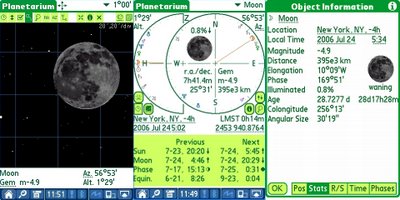 Panels showing Moon at 5:02AM and details at last sighting of 5:34AM.
Panels showing Moon at 5:02AM and details at last sighting of 5:34AM.
Location: John Finley Walk, Carl Schurz Park, NYC
Site Classification: Urban
Date/time: 24 July 2006, 4:10AM ~ 7:15AM
Moonrise: 4:46AM
Sunrise: 5:45AM
Handheld Binos: Fujinon 7x50, fov 7.5°
Tripod-mounted Binos: Takahashi 22x60, fov - 2.1°
====================================
Weather History
Transparency/Seeing (1 worst - 5 best): 4
NELM: 5.0, in Perseus
Conditions: Clear with some thin clouds stretch from south-southwest towards the east. Otherwise, clear and crisp eleswhere, Alpha Perseid Association, Pleiades and Hyades clear to the naked eye.
Observing party: Charlie, and me
---------------------------------------------------
Back on
27 May 2006, I saw my youngest crescent moon to date, a
19 hour waxing crescent. This morning I got my oldest Moon,
28.73 day old waning crescent. In terms of absolute time from a New Moon that's
18h57m, three minutes besting my personal record.
The period from New Moon to New Moon is known as synodic month, or lunation, with a value of 29.53 days. Charlie asked if this was a constant which I am thinking it is but not too certain.

I arrived around 0415 with coffee in hand at our usual bench on the John Finley Walk, Carl Schurz Park. Surprisingly there were some people about the area. 2 women in workout clothes walked by briskly - I'd see them pass both ways. Another lone guy was leaning on the railing looking out over the river. At first I thought it was Charlie but it be another 10 minutes or so before he showed.
While it was still dark, I grabbed some looks at M31 and Pleiades. With what an urban sky offers, I admired the starfield in and around Perseus. The sky was clear straight up, thin veils of cloud banded across the sky about 45° in altitude from the south-southwest reaching towards the east. Venus was brilliant above the bridge, easily to be mistaken for hovering helicopter.
Not long after Charlie arrived, twilight was coming on fast, a steady march as it climbed to the height of the bridge in no time; advancing with no obstacles. The Manhattan horizon was not yet as reddish or orangy as some mornings could be. Though the Moon was nearly 9.5° elongated from the Sun, leaving us a bit of a comfort zone. Compare that with the May crescent where elongation was 10°14'. When we spotted the crescent then the Sun was 2°57' below the horizon (no corrections for refraction).
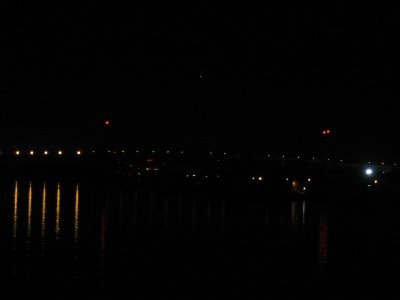
This is the before picture of Venus rising above the Triborough Bridge. Red lamps mark the top of the two bridge pilons. The lone red lamp to the left is about 3°29' in altitude.
To locate the Moon, I hopped from Venus to Castor and waited for Pollux to clear the brightening horizon. Haze was light. At 4:48AM I was still on Castor and then 5:00AM I found Pollux in the low horizon haze. It was attenuated but clearly visible in the Takahashi binoculars. Shortly after I panned the bins looking in a 3:30~ish direction and there was the crescent Moon, pretty bright in the bins just above the bridge span (roadway). It could have been as early as 5:01AM, however, I marked it as 5:02AM. The old crescent, about 150° of arc, rose from behind the Triborough Bridge, framed by its suspension wires. A fabulous sight and an exciting feeling.
I was surprised to see it as easily as I did and with so much contrast to the background sky. It was low at this sighting, a mere 1°29' in altitude. For 33 minutes I observed the Moon until I lost it after a field adjustment at 5:34AM. The prior adjustments I would lose the Moon for a bit, as if hitting a blind spot, until I was able to recover it in the field, but the last time I was unable to. I am thinking had I left it I could have watched it sail into the field stop a little longer.
 A snipping from TheSky6 showing relative positions of objects used for starhopping.
A snipping from TheSky6 showing relative positions of objects used for starhopping.As we observed it, Charlie and I were comparing our impressions aloud. He remarked that it was lumpy while I described it as having an pretty even crescent width until the reaching the horns. The last 15° ~ 30° near each it tapered off curving into the horn. In the bins I would say that this was an easy sight and we both agreed that there were bright patches/areas on the moon. To describe the orientation and length of the crescent in our field of view, we both agreed that it extended from 9 ~ 4 and the bright patches were seen in the areas of 5 o'clock, 6, and 7.
I regret not trying for naked eye. I was so excited about finding it and seeing it in the handheld bins, I didn't even stop to think of looking without optical aid. It became increasingly difficult to see the crescent in handheld Fujinon 7x50s. I would lose it long before I did in the Tak bins. The sky was brightening quickly as sunrise was getting closer.
In terms of absolute value from New Moon, this is the "youngest" that I have seen 18h57m, 4 minutes younger than the May young crescent. (4 because May's event was actually 19h01m). Illumination then was 0.9% whereas today it was 0.8%.
Only one woman passed and expressed interest at what Charlie and I were doing. At one point I lowered the tripod to allow her to look. After describing where to look she said she saw it. I am not quite sure she did because you know when pedestrians see something in the eyepiece, especially after they spend a moment or so looking but don't see. I could be wrong.
After the excitement we waited for the Sun to rise. Charlie brought his solar filters so we used his Canon 15x bins to see. We watched the Sun rise from behind a distant factory on the horizon. Later two sunspots were easily seen on the eastern side of the solar disk. This is sunspot 901 seen
here at spaceweather.com.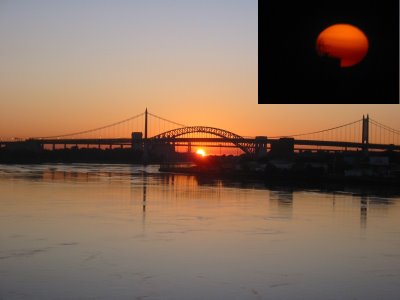 This is the after shot of the Sun rising. Charlie let me snap some photos through his bins, inset shows solar disk silhoutted by antennae on the factory roof. The Triborough Bridge is the large one in the foreground. I don't know the name of the arched one behind.
This is the after shot of the Sun rising. Charlie let me snap some photos through his bins, inset shows solar disk silhoutted by antennae on the factory roof. The Triborough Bridge is the large one in the foreground. I don't know the name of the arched one behind.I was packed up by 7AM though kept the Fujinon bins in hand. I had spotted Venus a couple times but couldn't get her naked eye. Charlie packed and un-packed his gear, attempting to see the ISS pass within a degree of Venus. As I futzed around with the computer, he mentioned that he didn't see it.
I was so impressed by how clear and azure blue the sky looked. After having some poor days and nights weatherwise, this was a godsend. Even walkng out of the park, I menetioned to Charlie how pretty the color composition of the green tree tops, red and off-white buildings and the blue sky. A perfect Monday morning.
Looking up: "Thank you"
Charlie's report can be found
here.
 Courtesy of Microsoft's Windows Live Local here is a map of some the observing locations in Central Park. Click on the photo to visit their Virtual Earth mapping app displaying my urban astronomy outposts.
Courtesy of Microsoft's Windows Live Local here is a map of some the observing locations in Central Park. Click on the photo to visit their Virtual Earth mapping app displaying my urban astronomy outposts.

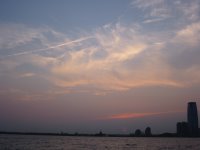
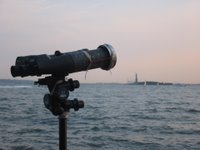
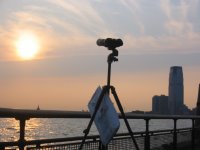











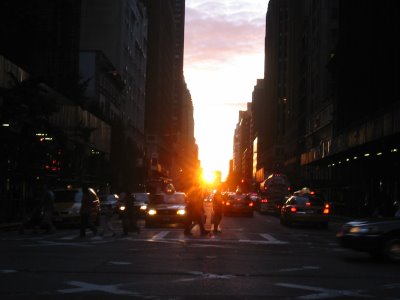
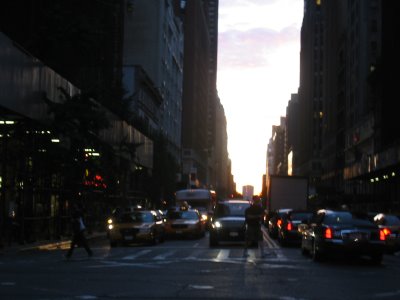
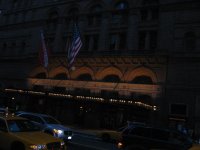
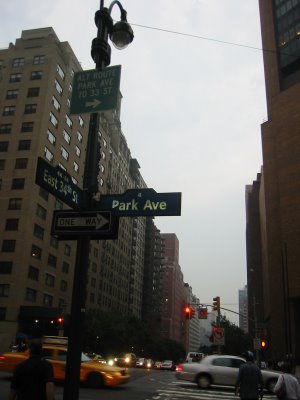

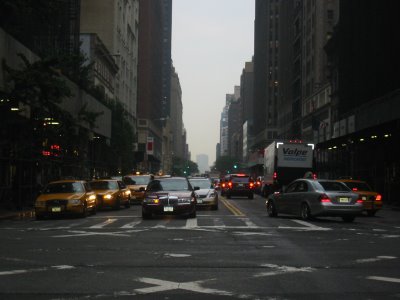
 On the brighter side, I did grab two cheeseburgers & fries from
On the brighter side, I did grab two cheeseburgers & fries from 





